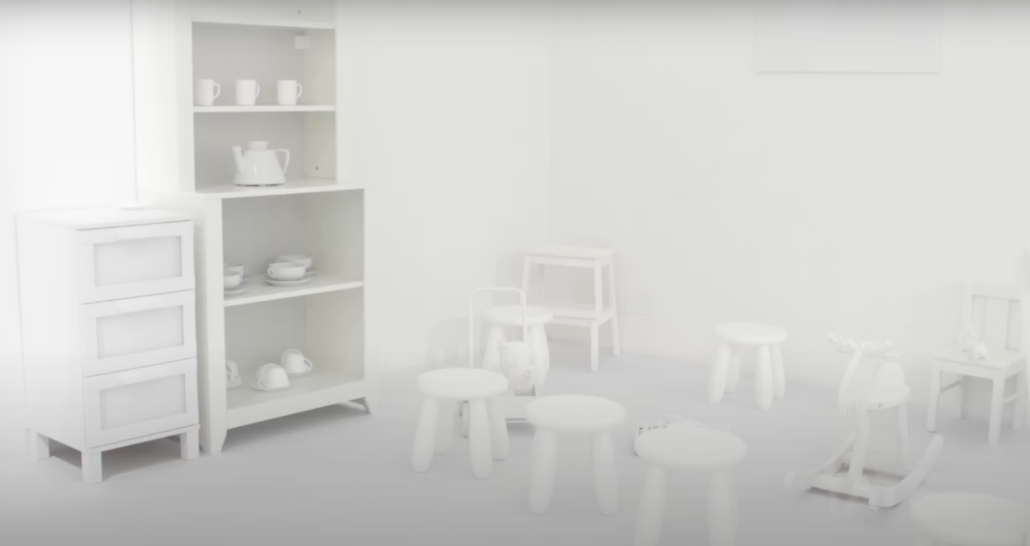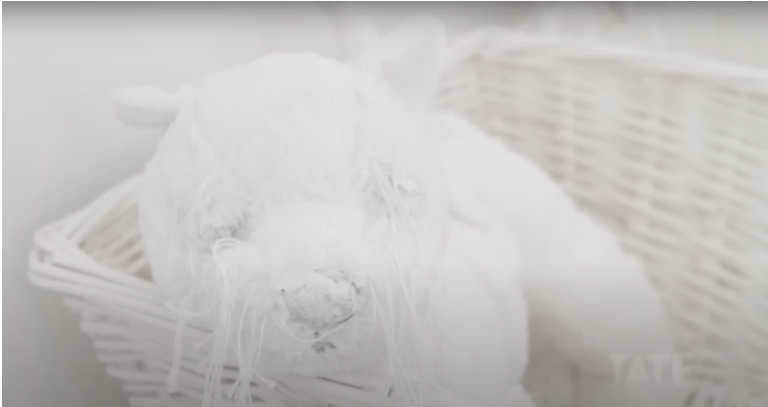Part 1: The Original Obliteration Room and Children “Play”
Children's Art
As mentioned previously, The Obliteration Room was initially commissioned for the Children’s Art Centre at QAGOMA, which comprises two floors of exhibition-related muti-media artistic activities designed for children aged up to twelve, although space is also open to teenagers and adults.[1] Artists who display works in the Children’s Art Center are invited by the museum to create child-friendly projects that emphasize interactivity and sensory participation to accompany exhibitions that are not specifically for children in the main section of the museum.[2] Despite catering to children through shape and size, The Obliteration Room was originally always open to adults. It could be argued that the adults participating in the work regress to a childlike state while interacting with the work, reverting the adult mind to a state of child’s “play.”
In this way, “play” then acts as a meaningful form of communication and discovery even though it is typically dismissed as frivolous and childish.[3] The energy and noise of children’s “play” runs counter to the expected quietness and thoughtfulness of the white cube gallery and museums as explored in Carol Duncan’s “The Art Museum as Ritual.”[4] This then acts as institutional critique, similar to Kusama’s intended “obliteration” of the white cube gallery previously discussed.[5] In 2002, the QAGOMA expected playful energy as the work was meant for young audiences who are naturally boisterous. However, as the audience became older and more diverse, they required the same childish energy to participate. With the proliferation of the Obliteration Room in many museums worldwide, play and playful behavior have now become co-opted by museums to drive traction as audiences become more expectant of the “experience” in which audiences favor events over commodities.[6]

Yayoi Kusama, The Obliteration Room, 2012.
Credit to Tate Modern and TateShots.
Still from https://www.youtube.com/watch?v=-xNzr-fJHQw&t=43s.

Yayoi Kusama, The Obliteration Room, 2012.
Tate Modern TateShots.
Still of room details https://www.youtube.com/watch?v=-xNzr-fJHQw&t=43s
Kusama’s work relies on a process of interaction wherein participation is an active form of institutional critique and encourages “play” within the piece. Play is sparked by the creative atmosphere of the installation in which participants are asked to subvert their normal expectations of museum space and interact with the artwork. The freedom of choice in the exhibition allows for regression to a child-like state in which audiences can then “play” and be spontaneous. Kusama’s Obliteration Room was originally explicitly meant for children, to whom “play” is a perfectly reasonable activity. Kusama also literally invites play by the inclusion of children’s toys like stuffed animals and rocking horses in her installations (Fig. 17).[7] Play fosters creativity and is a pursuit of pleasure typically scorned by adults for fear that it is childish, not-serious, inappropriate, detached, or disengaged from reality.[8] Play and participation in contemporary art have the potential to become political because they create tangible forms of interaction amongst audience members by allowing for communication outside of capitalist exchange.[9] When the participants are given the same goal of placing stickers on the white walls, the action of play in The Obliteration Room allows for the creation of a sense of community. Individuals may compete for blank spots, but overall, they share the common “goal” of working together to “obliterate” the installation. “Play” also can induce awareness of oppression and inequality and their potential eradication, as well as incite creative thinking that operates outside of societal norms and structures.[10]
“Play” exists only when there is an open (or presumed to be open) number of possibilities, so when possibilities are exposed as predetermined, “play” ceases to exist, and the political potential of play and the appearance of free “play” is dismantled. It is then assumed that possibilities are constricted or limited. Play fundamentally requires spontaneity or at least the assumption of spontaneity; one must be free from inhibitions. It exists to escape the predetermined rigid social hierarchy and repetitive work as everyone is considered equal and given the same task.[11] There is no privilege given to any participants, regardless of age, sex, class, or social status. Play has the potential to create socio-political ramifications as it allows people to break out of the banality of their everyday life and perform new actions. This potential then allows for the transformative potential of the work to those who participate.
[1] “Kids & Families – Queensland Art Gallery | Gallery of Modern Art,” Queensland Art Gallery.
[2] “The Gallery of Modern Art – Children’s Art Centre,” Brisbane Kids.
[3] Mallett, “Preventing Predictions,” 8.
[4] Carol Duncan, “The Art Museum as Ritual,” The Art Bulletin (New York, N.Y.) 77, no. 1 (1995): 10-13.
[5] O’Doherty, Inside the White Cube, 15, 25, 49-50.
[6] Joseph B. Pine and James H. Gilmore, The Experience Economy, 12; Further discussed in the later section, “Kusama, Her Brand, and The Experience Economy.”
[7] Piper, “’The joy of this exhibit is how much it invites play.’”
[8] Mallett, “Preventing Predictions,” 9, 37-38.
[9] Mallett, “Preventing Predictions,” 9, 37-38.
[10] Mallett, “Preventing Predictions,” 9.
[11] Mallett, “Preventing Predictions,” 9, 37-38; “Non-competitive playing can reduce alienation in a busy, impersonal world because it enacts an enjoyable bonding force wherein the expression of the unique imagination and perspective of each individual is appreciated.” –Mallett, “Preventing Predictions,” 36.
